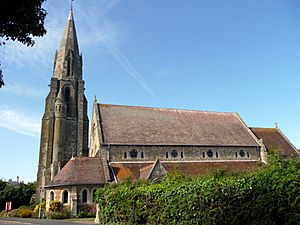Church of St Saviour-on-the-Cliff, Shanklin facts for kids
Quick facts for kids The Church of St. Saviour-on-the-Cliff, Shanklin |
|
|---|---|
 |
|
| Denomination | Church of England |
| Churchmanship | Anglo-Catholic |
| Website | [1] |
| History | |
| Dedication | St. Saviour |
| Administration | |
| Parish | Shanklin |
| Deanery | East Wight Deanery |
| Archdeaconry | Isle of Wight |
| Diocese | Portsmouth |
| Province | Canterbury |
The Church of St. Saviour-on-the-Cliff is a special old church in Shanklin, on the Isle of Wight. It's part of the Church of England and is considered a Grade II Listed building. This means it's an important historical place.
Building the Church: A Look at Its History
The Church of St. Saviour-on-the-Cliff was built over many years, from 1869 to 1905. A famous architect named Thomas Hellyer designed it.
Laying the First Stone
The very first stone for the church was placed on Ascension Day in 1867. This was a special day to begin such an important project.
First Parts of the Church
The first part of the church to be finished included the main hall (Nave), the area around the altar (Chancel), the Vestry, and the Organ Chamber. This first stage cost about £2,789. Bishop Vincent William Ryan officially opened and blessed the church on May 7, 1869. He was the first Bishop of Mauritius.
Adding New Features Over Time
The church continued to grow. In 1871, a side area called the South Aisle and a Porch were added. Later, in 1876, the North Aisle and the Church Hall were built. The last major building work happened in 1905. This included the Baptistry, where baptisms take place, and a planned entrance area called the Narthex.
The church's pulpit, where sermons are given, was designed and carved in 1903. A talented artist named Miss Editha Plowden created it. The original pulpit from St. Saviour's was moved to St. John's Church in Bournemouth, where you can still see it today.
Surviving the War Years
It's amazing that the church survived the war years with only a little damage. Just a few windows were broken. You can still see this damage in the East window of the Memorial Chapel. You can also spot it in the West windows at the back of the church. One of the Baptistry windows also shows signs of damage.
Special Details Inside the Church
The arch above the Chancel has a unique painted message. It says, "Draw near with a true heart in full assurance of faith". This is the only example of Victorian painted text in the church.
When you stand at the entrance of the Galilee Porch and look towards the High Altar, you can truly appreciate the church's beauty. The inside of St. Saviour's is very richly decorated. Many generous gifts have been added over the years.
The Church Tower and Its Bells
In 1883, the Vicar, Revd Charles I Burland, had a big idea. He wanted to add a tall tower to St. Saviour's. This tower would have "pealing bells" that would ring out.
Building the Tower and Installing Bells
By early 1887, the tower and its pointed top (spire) were finished. The next year, a set of eight bells was put into the tower. These bells were made by a company called Mears and Stainbank in London. All the bells together weigh about 75 hundredweight (cwt). The largest bell alone weighs about 18 cwt. (A hundredweight is about 112 pounds).
Challenges with the Bells
At first, everyone was very excited about the new tower and bells. However, problems soon appeared. By 1900, the tower and spire needed repairs. The bells were hung too high inside the tower. Also, the tower itself was not very steady. Because of these issues, the bells could only be chimed, not fully rung, from 1925 to 1985.
Restoring the Bells
In 1985, the decorative tops (pinnacles) were removed from the tower. A report confirmed the tower was safe. Then, a lot of hard work began to clean out 60 years of dirt and debris. The bells were in very bad shape after hanging still for a century in salty air. Workers removed 56 bags of pigeon droppings from the tower! It was clear that a lot of effort was needed to save the bells for the future.
After eight years of amazing fundraising, the bells were taken out of the tower. They were restored with new parts like headstocks, stays, wheels, and clappers. They were then hung back in their original frame, ready to ring again.
The Church Organ
The church has a pipe organ that was built in 1874. It was made by a company called J. W. Walker & Sons Ltd. The organ is located in the chancel, on the north side of the church. It has two keyboards for playing notes with your hands. It also has four pedals that can be played with your feet. You can find more details about this organ on the National Pipe Organ Register website.

